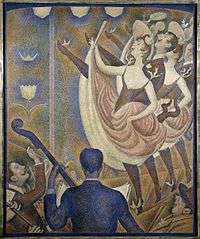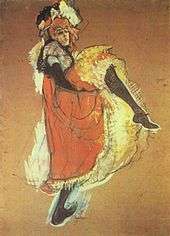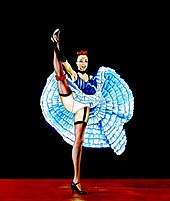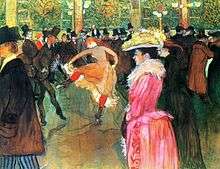Can-can
The can-can (also spelled cancan as in the original French /kɑ̃kɑ̃/) is a high-energy, physically demanding dance that became a popular music-hall dance in the 1840s, continuing in popularity in French cabaret to this day.[1] Originally danced by both sexes, it is now traditionally associated with a chorus line of female dancers.[2] The main features of the dance are the vigorous manipulation of skirts and petticoats, along with high kicks, splits, and cartwheels.
_1895-6.jpg)
History


The can-can is believed to have evolved from the final figure in the quadrille, a social dance for four or more couples.[3] The exact origin of the dance is obscure,[4] but the steps may have been inspired by a popular entertainer of the 1820s, Charles Mazurier, well known for his acrobatics, including the grand écart or jump splits—both popular features of the can-can.[5]
The dance was considered scandalous, and for a while there were attempts to suppress it. This may have been partly because in the 19th century, women wore pantalettes, which had an open crotch, and the high kicks were intentionally revealing. There is no evidence that can-can dancers wore special closed underwear, although it has been said that the Moulin Rouge management did not permit dancers to perform in "revealing undergarments".[6] Occasionally, people dancing the can-can were arrested, but there is no record of its being banned, as some accounts claim. Throughout the 1830s, it was often groups of men, particularly students, who danced the can-can at public dance-halls.[7]
As the dance became more popular, professional performers emerged, although it was still danced by individuals, not by a chorus line.[8] A few men became can-can stars in the 1840s to 1861 and an all-male group known as the Quadrille des Clodoches performed in London in 1870.[9] However, women performers were much more widely known.
The early can-can dancers were probably prostitutes, but by the 1890s, it was possible to earn a living as a full-time dancer and stars such as La Goulue and Jane Avril emerged, who were highly paid for their appearances at the Moulin Rouge and elsewhere.[10][11] The most prominent male can-can dancer of the time was Valentin le Désossé (Valentin the Boneless) a frequent partner of La Goulue. The professional dancers of the Second Empire and the fin de siècle developed the can-can moves that were later incorporated by the choreographer Pierre Sandrini in the spectacular "French Cancan", which he devised at the Moulin Rouge in the 1920s and presented at his own Bal Tabarin from 1928. This was a combination of the individual style of the Parisian dance-halls and the chorus-line style of British and American music halls (see below).[12]
Outside France
In the United States and elsewhere, the can-can achieved popularity in music halls, where it was danced by groups of women in choreographed routines. This style was imported back into France in the 1920s for the benefit of tourists, and the "French Cancan" was born—a highly choreographed routine lasting ten minutes or more, with the opportunity for individuals to display their "specialities". The main moves are the high kick or battement, the rond de jambe (quick rotary movement of lower leg with knee raised and skirt held up), the port d'armes (turning on one leg, while grasping the other leg by the ankle and holding it almost vertically), the cartwheel and the grand écart (the flying or jump splits). It has become common practice for dancers to scream and yelp while performing the can-can.
The can-can was introduced in America on 23 December 1867 by Giuseppina Morlacchi, dancing as a part of The Devil's Auction at the Theatre Comique in Boston. It was billed as "Grand Gallop Can-Can, composed and danced by Mlles. Morlacchi, Blasina, Diani, Ricci, Baretta ... accompanied with cymbals and triangles by the coryphees and corps de ballet." The new dance received an enthusiastic reception.
.jpg)
By the 1890s the can-can was out of style in New York dance halls, having been replaced by the hoochie coochie.[13]
The can-can became popular in Alaska and Yukon, Canada, where theatrical performances feature can-can dancers to the present day.
Perception

The can-can is now considered a part of world dance culture. Often the main feature observed today is how physically demanding and tiring that the dance can be to perform, but it still retains a bawdy and suggestive element in dance culture.
When the dance first appeared in the early 19th century, it was considered a scandalous and repulsive dance, similar to how rock and roll was perceived in the 1950s. Similarly in the mid-19th century, it was often viewed morally reprehensible, due to its erotic context, and the once-popular moral code of women having to suppress exposure of their legs in public. In the late 19th and early 20th centuries, the can-can was viewed as much more erotic because the dancers made use of the extravagant underwear of the period, and the contrasting black stockings. They lifted and manipulated their skirts much more, and incorporated a move sometimes considered the most cheeky and provocative; bending over and throwing their skirts over their backs, presenting their bottoms to the audience (this gesture is often referred to as the "derrière"). The Moulin Rouge dancer La Goulue was well known for this gesture, and had a heart embroidered on the seat of her drawers.
A can-can dancer would sometimes stand very close to a man, and bet that she could take off his hat without using her hands. When he took the bet, she would execute a high kick that would take off his hat—and give him a quick look at her pantaloons while she was at it. It was also a warning that anyone taking unwanted liberties with a dancer could expect a kick in the face.
Early editions of The Oxford Companion to Music defined the can-can as a "boisterous and latterly indecorous dance of the quadrille order, exploited in Paris for the benefit of such British and American tourists as will pay well to be well shocked. Its exact nature is unknown to anyone connected with this Companion."[14]
In other arts

Many composers have written music for the can-can. The most famous music is French composer Jacques Offenbach's Galop Infernal in his operetta Orphée aux Enfers (Orpheus in the Underworld) (1858).[15] However, the galop is actually another sort of dance. Other examples occur in Franz Lehár's operetta The Merry Widow (1905) and Cole Porter's musical play Can-Can (1954), which in turn formed the basis for the 1960 musical film Can-Can starring Frank Sinatra and Shirley MacLaine. Some other songs that have become associated with the can-can include Aram Khachaturian's "Sabre Dance" from his ballet Gayane (1938) and the music hall standard "Ta-ra-ra Boom-de-ay". In 1955 Jean Renoir's film French Cancan, starring Jean Gabin as the director of a music hall which features the can-can, was released.
The can-can has often appeared in ballet, most notably Léonide Massine's La Boutique fantasque (1919) and Gaîté Parisienne (1938),[16] as well as The Merry Widow. A particularly fine example can be seen at the climax of Jean Renoir's film French Cancan, mentioned above.[17] Another well-known can-can occurs at the finale of the "Dance of the Hours" from the opera La Gioconda by Amilcare Ponchielli.
French painter Henri de Toulouse-Lautrec produced several paintings and a large number of posters of can-can dancers. Other painters to have treated the can-can as a subject include Georges Seurat, Georges Rouault, and Pablo Picasso.[18]
References
- Nadège Maruta, L'Incroyable Histoire de Cancan: Rebelles et Insolentes, les Parisiennes Mênent la Danse (Paris: Parigramme, 2014).
- Marie-Franççpose Christout, "Can-can," in International Encyclopedia of Dance, edited by Selma Jeanne Cohen and others (New York: Oxford University Press, 1998), vol. 2, pp. 52-53.
- Mary Clarke, "Quadrille," in The History of Dance (New York: Crown, 1961).
- Francis Henry Gribble, "The Origin of the Can-can" (1933), reprinted in Dancing Times (London), October 1953, pp. 28-29, 66-67.
- G. Desrat, "Mazurier, Charles," in Dictionnaire de la Danse Historique, Théorique, Pratique et Bibiographique, depuis l'Origine de la Danse jusqu'a Nos Jours (1895), Classic Reprint (London: Forgotten Books, 2017).
- Jacques Pessis and Jacques Crépineau, The Moulin Rouge (New York: St. Martin's Press, 1990).
- Marie-Françoise Christout, "Can-Can", in International Encyclopedia of Dance (1998).
- Renée Camus, "Cancan: Blurring the Line between Social Dance and Stage Performance", in Proceedings of the annual meeting of the Society of Dance History Scholars, Baltimore, Md., 2001/
- Alfred Choubrac, Ambassadeurs: Quadrille des Clodoches (Colombes: Atelier Choubrac, 1890).
- Michel Souvais, Moi, La Goulue de Toulouse-Lautrec: Mémoires de Mon Aïeule (Paris: Publibook, 2008).
- Jane Avril, Mes Mémoires (Paris: Phebus, 2005).
- Philippe Le Moal , ed., "Sandrini, Pierre", in Dictionnaire de la Dansw (Paris: Éditions Larousse, 1999.
- Herbert Ashbury, The Gangs of New York (New York: Knopf, 1929).
- Percy Alfred Scholes, ed., The Oxford Companion to Music (Oxford University Press, 1934), p. 134.
- The Earl of Harewood and Antony Peattie, eds. "Jacques Offenbach: Orphée aux Enfers", in The New Kobbé's Opera Book, 11th ed. (New York: G. P. Putnam's, 2000), p. 575.
- Debra Crane and Judith Mackrell, "Can-can", in The Oxford Dictionary of Dance (Oxford University Press, 2000).
- Criterion Collection, released by United Motion Pictures, 1955.
- David Price, Cancan! (London: Cygnus Arts, 1998).